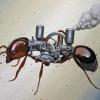- Formiculture.com
- Forums
- Gallery
- Members
- Member Map
- Chat

Colony with Dead Queen
Started By
Works4TheGood
, Oct 28 2015 2:42 PM
6 replies to this topic
#1
 Offline
-
Posted October 28 2015 - 2:42 PM
Offline
-
Posted October 28 2015 - 2:42 PM
I lost my first queen today that had workers. Yay! I tried to console myself saying, "You're not a REAL man until you've lost your first ant colony."  It may have been the mold accumulating on the cotton, or maybe it was the preservative-loaded Frosted Flakes I've been lazily feeding them, or maybe it was just chance. Anyway, I have several other of these queens in reserve. Can I transfer the remaining brood and/or workers to them somehow?
It may have been the mold accumulating on the cotton, or maybe it was the preservative-loaded Frosted Flakes I've been lazily feeding them, or maybe it was just chance. Anyway, I have several other of these queens in reserve. Can I transfer the remaining brood and/or workers to them somehow?
~Dan
#2
 Offline
-
Posted October 28 2015 - 2:49 PM
Offline
-
Posted October 28 2015 - 2:49 PM
Transferring the brood should be fine, but making sure there is no mites I suppose.
#3
 Offline
-
Posted October 28 2015 - 5:41 PM
Offline
-
Posted October 28 2015 - 5:41 PM
I would transfer the brood and not the workers. I would allow them to live out there lonely lives until they all perish. Sorry about your queen.
Current Colonies;
Acromyrmex Versicolor
Dorymyrmex Bicolor
Pogonomyrmex Californicus
Pogonomyrmex Rugosus
Pogonomyrmex Tenuispinus
Novomessor Cockerelli
Myrmecocystus Mexicanus
Last Update: 08 Jul 2016
#4
 Offline
-
Posted October 29 2015 - 6:21 AM
Offline
-
Posted October 29 2015 - 6:21 AM
Brood should be fine.
Workers may fight, if you have a queen with no workers you can try putting just the workers in the fridge for 3-5 days then introducing one worker to a queen. They may fight, they may not. Nanitics are often a rule to themselves, and it can vary by species. You can introduce one worker and see how it goes, a queen should not have much difficulty in fighting one nanitic and chances are the nanitic will run if she has no intention of adopting a new queen or fighting. (Nanitics rarley want to fight, unless something enters their own nest - which is why you put one worker in the new queens tube).
"Always do right. This will gratify some people, and astound the rest." -- Samuel Clemens
#5
 Offline
-
Posted October 29 2015 - 2:09 PM
Offline
-
Posted October 29 2015 - 2:09 PM
One thing to make sure to check though is the temperature of your fridge and the highest and lowest temperatures at which your species can survive, or you risk killing the workers off. I have experimented quite a bit with worker boosting times and variables and have found that (in my particular case), if i put them in the fridge for 5 minutes, let them air out in an open shallow-ish container for a day, then put them in for two five minute intervals in the fridge ten minutes apart from each other, that even full blown colonies accept the workers as sisters of themselves. If the ant species that your referring to is good at climbing, then you may have to put fine mesh, fluon, talcum powder, paraffin oil, ect. on the top of the open container.
I also fully believe that a long cool-down time in the fridge would work just as effectively as Crystals said. In my experiments the cool-down is also much more effective if the container is left open (after they are chilled you can then open the container with no worry of escapees if they excel at climbing). I've also had quite a few successes at merging queens into colonies. Send me a message if you'd like to know more.
p.s. I do not recommend placing the chilled ants in question into the nest until they are somewhat able to move.
A question that sometimes drives me hazy: am I or are the others crazy?
#6
 Offline
-
Posted October 30 2015 - 6:46 AM
Offline
-
Posted October 30 2015 - 6:46 AM
Thank you all for the great advice!
Does anyone understand why cooling and then warming a worker again would make it more receptive to a new queen and why doing it multiple times would increase receptivity? I certainly believe you guys, but I also want to understand the physics.
~Dan
#7
 Offline
-
Posted October 30 2015 - 7:37 AM
Offline
-
Posted October 30 2015 - 7:37 AM
There is little to no evidence that temperature plays a role in workers accepting a new queen. Nestmate scent association is formed early after eclosing, and studies show that ants with partially amputated antennae no longer attacked other ants from a different colony (but also didn't live very long, if I recall correctly) (citation needed).
If a positive outcome is resulting from the temperature acclimation technique, it is likely that one scent is covering up the other, given the close proximity and duration of exposure in the cool environment, where the ants are less likely to react adversely with one another, only to awaken to a more homogenized colony scent than before. This can give one the illusion that temperature is the independent variable, when actually it is just a condition for the other mechanics to fall in place.
In any case, the technique is not usually successful with ants, in general.
Edited by drtrmiller, October 30 2015 - 7:37 AM.
byFormica® is the manufacturer of the iconic nectar feeders and Sunburst Ant Nectar.
byFormica ant products always deliver consistent performance, convenience,
and reliability, making them among the most beloved ant foods and kit enjoyed by
ant keeping enthusiasts worldwide. For more information, visit www.byFormica.com.
1 user(s) are reading this topic
0 members, 1 guests, 0 anonymous users




















